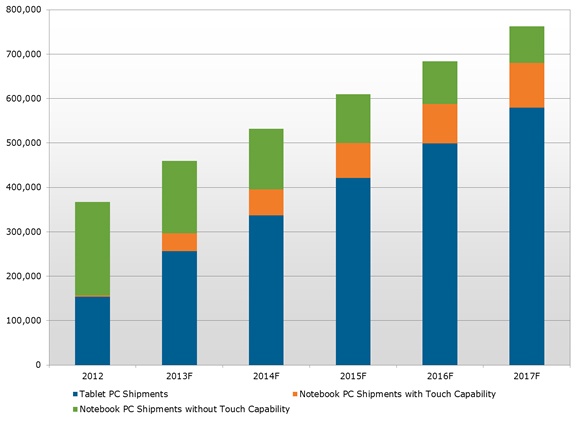Tablet Sales to Triple Laptops by 2017, Says NPD

Source: NPD DisplaySearch
Tablets will replace traditional notebooks as the dominant mobile PC form factor this year, says analyst firm NPD, and will more than triple the number of laptop shipments within four years. Low-cost slates, many of which are made in China, will put an increasing amount of pressure on PC makers as the market evolves.
It's not all bad news for notebooks. Shipments of laptops with touch capabilities are expected to grow 48 percent in 2014, spurred by a new wave of Windows 8 Ultrabooks and a predicted touch-based MacBook Air.
MORE: Top 10 Tablets
Overall, NPD predicts 579.4 million tablet shipments by 2017, compared to 183.3 million for notebooks. That represents a 10 percent decline for laptops over the next four years.
NPD doesn't see Windows 8 as much of a driver for growth as falling costs and new types of designs, such as sliders and convertibles. “Thus far, Windows 8 has had a limited impact on driving touch adoption in notebook PCs, due to a lack of applications needing touch and the high cost of touch on notebook PCs,” said Richard Shim, senior analyst with NPD DisplaySearch.
We're already seeing a lot of experimentation with hybrids, such as the Acer Aspire P3 unveiled last week. This $799 Ultrabook looks like a tablet but has the Core i5 power of a notebook paired with a Bluetooth keyboard case.
Stay in the know with Laptop Mag
Get our in-depth reviews, helpful tips, great deals, and the biggest news stories delivered to your inbox.
What Microsoft really needs, though, are sub-$400 tablets to battle the iPad mini, Nexus 7 and the Kindle Fire HD on the low end of the market. Those devices could debut at Microsoft's Build conference in June, where the company is rumored to show off new 7-to-9 inch versions of the Surface.

